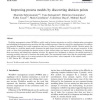Free Online Productivity Tools
i2Speak
i2Symbol
i2OCR
iTex2Img
iWeb2Print
iWeb2Shot
i2Type
iPdf2Split
iPdf2Merge
i2Bopomofo
i2Arabic
i2Style
i2Image
i2PDF
iLatex2Rtf
Sci2ools
IS
2007
2007
Improving process models by discovering decision points
Workflow management systems (WfMS) are widely used by business enterprises as tools for administrating, automating and scheduling the business process activities with the available resources. Since the control flow specifications of workflows are manually designed, they entail assumptions and errors, leading to inaccurate workflow models. Decision points, the XOR nodes in a workflow graph model, determine the path chosen toward completion of any process invocation. In this work, we show that positioning the decision points at their earliest points can improve process efficiency by decreasing their uncertainties and identifying redundant activities. We present novel techniques to discover the earliest positions by analyzing workflow logs and to transform the model graph. The experimental results show that the transformed model is more efficient with respect to its average execution time and uncertainty, when compared to the original model. r 2007 Elsevier B.V. All rights reser...
| Added | 15 Dec 2010 |
| Updated | 15 Dec 2010 |
| Type | Journal |
| Year | 2007 |
| Where | IS |
| Authors | Sharmila Subramaniam, Vana Kalogeraki, Dimitrios Gunopulos, Fabio Casati, Malú Castellanos, Umeshwar Dayal, Mehmet Sayal |
Comments (0)

